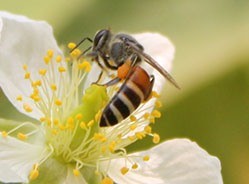Black dwarf honey bee
(Apis andreniformis)

Description
Apis andreniformis, or the black dwarf honey bee, is a relatively rare species of honey bee whose native habitat is the tropical and subtropical regions of Southeast Asia. A. andreniformis was the fifth honey bee species to be described of the seven known species of Apis. Until recently, however, the actual identity of the species was poorly understood. It was not recognized as its own species, but was instead considered to be a part of the species Apis florea. Recent studies have highlighted notable differences between the bees and have thus separated them into distinct species. A. andreniformis can be distinguished from other Apis species by noting their dark black coloration, making them the darkest of their genus. Originally, it was thought that A. andreniformis was a part of the species A. florea, but recent studies have noted morphological differences that have separated the two. Some distinctions include: structural differences in the endophalli, a larger wing venation in A. andrenifromis, and a longer basitarsal extension in A. florea. Additionally, there are slight color variations between the two species. In A. andreniformis, its first two abdominal segments are black and its scutellum is yellow. In A. florea, the abdominal segments are reddish brown and their scutellum is black. Another distinguishing factor is the presence of black hairs on the tibia of A. andreniformis, which are white in A. florea. Other differentiating characteristics include cubital indexes and proboscis length. A. andreniformis has an index of 6.37, while A. florea has one of 2.86. The proboscis of A. andreniformis has a length of 2.80 mm, while that of A. florea is 3.27 mm. Within the species, queens can be distinguished from workers and drones by their near entire black coloration. In contrast, worker bees have lighter, almost yellow scutellums, as described previously. A. andreniformis is found in southeast Asia, specifically southern China, India, Burma, Laos, Vietnam, Thailand, Malaysia, Indonesia, and the Philippines. They are commonly found in sympatric distribution with A. florea. Although they are sympatrically distributed, it is uncommon to have nests of different species in the same tree or bush. Each species tends to be found closer to nests of its own species rather than its sister species.
Taxonomic tree:







